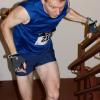But wasn't the equivalent mouse to human dosage from the study around 30 mg for a 70 kg person? Thought I read that calculation in past pages. If so, you took 10 times that amount in the 300 mg dose.
I agree that it should be taken very infrequently.
Thanks for bringing this up, and reminding me to re-examine the dosage.
The general conversion from mouse to human dosage is really a fudge factor meant to be used to determine the baseline starting point for phase 1 testing of safety and pharmacokinetics. It does give around 30mg.
It is very conservative.
But good news, there is already pharmacokinetic information about dasatinib in humans and we can base our speculation on that.
This is a very interesting analysis that was done when they first wanted to test dasatinib in humans for cancer:
http://clincancerres...3/7180.full.pdf
There's a lot of information packed in there and will take me a while to fully digest, but here are a couple key points as I see it. Please anyone correct my assumptions. I'm a novice at this.
Two alternative trains of thought:
1. In mice they were testing dosages of 1.25, 2.5, and 5 mg/kg at different intervals. They determined minimum effective was 1.25 twice a day or 2.5 once a day. After considering what was already known about the human pharmacokinetics they determined that 70mg twice a day or 140mg of dasatinib would be ideal for humans. Which initially did end up as being the starting point for human use I think. Today (I think) the preferred starting dose is 100mg once a day, rather than 70mg twice.
2. Looking at the pharmacokinetics in mice vs humans the "area under the curve" (blood concentration over time) is pretty close for 5mg ==> 100mg.
Following the logic of #1 I would probably end up with 200mg as it seems like 2.5mg ==> 100mg or 140mg. And in our study the mice took 5mg/kg.
But #2 is actually pretty convincing. So might want to stick with the 100mg range.
Of course one could then tailor the values to individual body masses, for example I'm quite a bit more than 70kg.
Edited by roguereason, 19 October 2017 - 03:43 PM.























































